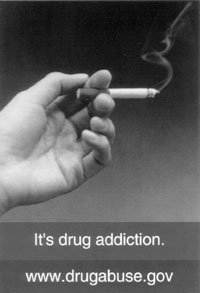Pursuing New Medications

In recent years, people from all walks of life have sought treatment for addiction to powerful narcotic pain-relieving medications, such as OxyContin and Vicodin, that they have abused outside of a medical regimen. These medications share many properties with heroin, which currently ensnares more than a million people nationwide in the web of addiction. Those who become addicted to legal painkillers or street opiates now have a new medication to help them reclaim their lives. Approved by FDA in 2002, buprenorphine joins two other approved opiate treatment medications--methadone, used in long-term treatment, and the NIDA-developed opiate blocker naltrexone, used to help patients remain drug-free after they have stopped using opiates.
Buprenorphine is the first medication for opiate addiction treatment that can be prescribed by private physicians in offices and clinics. Use of this medication in mainstream medicine should help reduce the stigma still associated with drug abuse treatment, while encouraging more patients to seek treatment for addiction to heroin and other opiates. NIDA also is pursuing medications for cocaine and methamphetamine abuse and addiction, for which no medications are yet available. To fill this void, the Institute is applying the same scientific medications development methodologies that put effective opiate treatment medications into the hands of clinicians and their patients.

On one research track, clinical researchers are screening medications previously approved to treat other disorders. In these small-scale trials, several agents have appeared to weaken the addictive cycle of drug-craving, drug-seeking, and drug-taking. Among them are amantadine (currently used for Parkinson's disease), disulfiram (Antabuse), baclofen (an antispasticity agent), tiagabine and topiramate (antiepileptics), and modafinil (used in narcolepsy). Disulfiram and naltrexone, both effective in treating alcoholism, may fill a critical need for medications that can help cocaine-abusing individuals who also abuse alcohol. Propranolol, a medication used to lower blood pressure, may help substance abuse patients stay the course during the critical early days of treatment, by alleviating their unpleasant withdrawal symptoms. Researchers are now conducting larger, longer studies to confirm these encouraging results. Because the medications work by a variety of different mechanisms, some of which may complement each other, researchers also will examine whether they may be more effective in combination than alone. Some may also work optimally with specific behavioral therapies.
On another track, researchers in NIDA's cocaine and methamphetamine treatment discovery programs are working to identify new chemical compounds whose pharmacological actions modulate the effects of psychostimulants on the brain and behavior. They already have shown that one compound that blocks a brain cannabinoid receptor can prevent animals from reinitiating cocaine use after exposure to drug-related cues and stressful events. Other compounds that curb the drug-induced flooding of the brain's reward pathways with dopamine may be able to treat addiction to all abused drugs. Still other compounds counter psychostimulants' ability to activate receptor molecules, nerve networks, and neurochemical mechanisms to create pleasure and craving.
 NIDA uses art cards, displayed in restaurants and other public places, to warn smokers that nicotine, like other drugs, can be addictive.
NIDA uses art cards, displayed in restaurants and other public places, to warn smokers that nicotine, like other drugs, can be addictive.Another NIDA initiative is focusing on new medications for treating nicotine addiction. Launched in the 1970s, NIDA's basic research in this area provided the scientific basis for nicotine replacement therapies, such as the transdermal patch, that today help many patients overcome nicotine dependence. The Institute is now pursuing several approaches to medications that could intercept and neutralize nicotine, cocaine, and methamphetamine in the bloodstream before they can act in the brain. In one approach, vaccines containing the abused substance are linked with a larger carrier molecule and stimulate the to produce antibodies to the drug. Another approach enhances the rate at which the 's enzymes break down the drug molecules into inactive byproducts.
Identifying Effective Behavioral Therapies
Therapies that help drug abuse patients overcome erroneous thought patterns and behaviors that reinforce their abuse and addiction are critical in treating drug abuse and preventing its harmful consequences. Cognitive-behavioral therapies can stand alone as front-line interventions that help many patients stop using drugs and remain drug-free. And they can increase the effectiveness of treatment medications by boosting patients' motivation to remain in treatment, take their medication as scheduled, and learn strategies to avoid relapse and lead drug-free lives. NIDA-supported research has demonstrated that combining medications, as available, with behavioral treatments is the best way to enhance success for most patients.

Over the last decade, NIDA's Behavioral Therapies Development Program established a three-stage process to develop and introduce new behavioral approaches into clinical practice, similar to that required by the Food and Drug Administration to establish the safety and efficacy of medications. Building on research that suggests avenues for developing new therapies or refining existing ones, pilot studies explore the potential of each new or refined treatment. Those showing promise are then tested in research settings in small- and large-scale clinical trials. Finally, clinical trials can be done in community settings for those therapies that demonstrate therapeutic efficacy.
 Family therapies tailored to the ethnicity or race of substance-abusing teens have proven successful.
Family therapies tailored to the ethnicity or race of substance-abusing teens have proven successful.NIDA behavioral therapy researchers have designed several cognitive-behavioral therapies to help methamphetamine abusers. One innovative therapy gives patients a voucher each time they submit a drug-free urine sample. Vouchers may be exchanged for goods or services that provide pleasurable, legal alternatives to drug use or, as in methadone treatment programs, for special privileges, like reducing the number of required visits to a treatment clinic. Studies show that providing vouchers for drug-free urine tests can help patients stop cocaine and methamphetamine use and remain abstinent for extended periods. Variations of voucher-based therapies that use lower cost vouchers or involve family and other community resources in treatment can be matched to the resources of treatment programs and needs of cocaine-addicted individuals.
In the last 10 years, behavioral treatments have demonstrated their potency in improving the health of diverse individuals with many types of drug abuse and other mental disorders. Proven treatments include individual cognitive-behavioral therapy, family therapies for Hispanic and African-American adolescent substance abusers, combination behavioral and medication therapies for adult smokers, and couples therapy for opiate-addicted men and women in methadone treatment programs. The benefits of many of these treatments endure long after treatment has ended. And with individual cognitive-behavioral therapy, the benefits appear to increase over time.